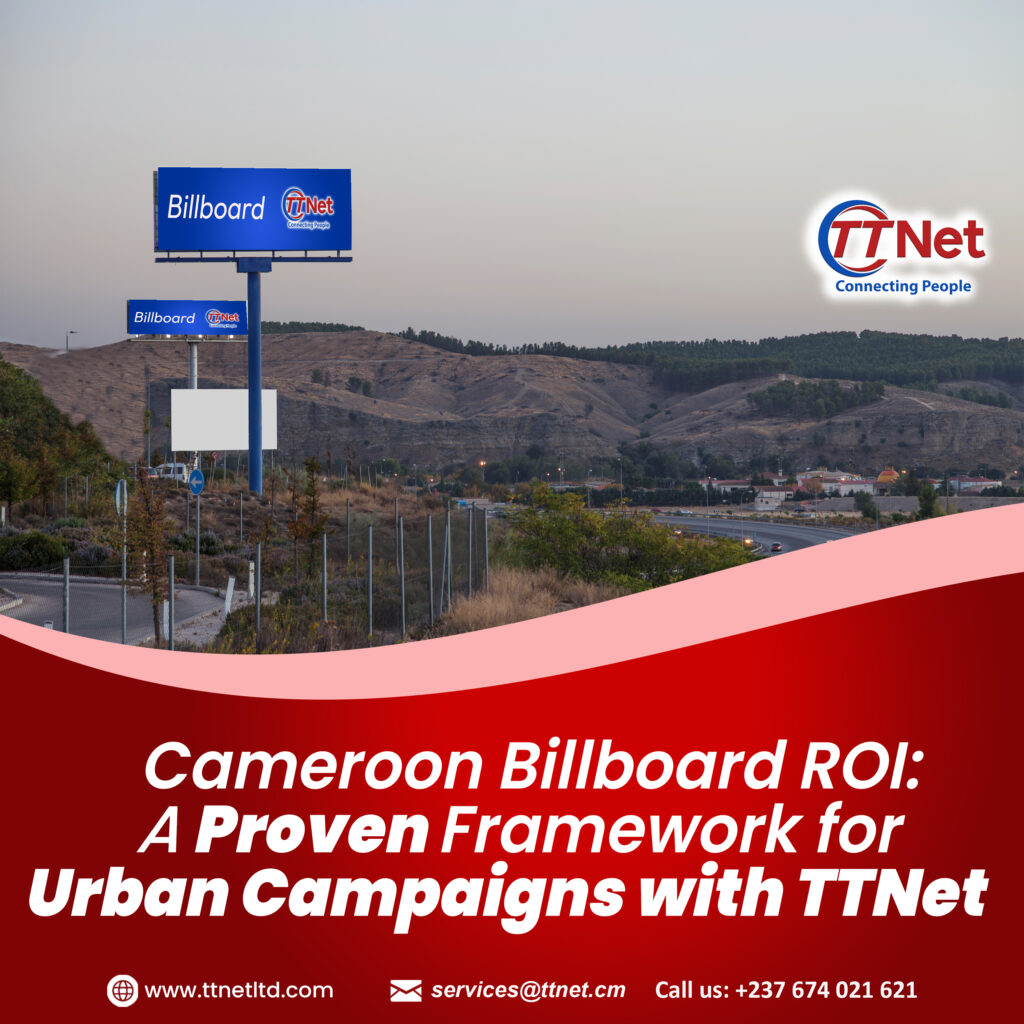
Outdoor advertising remains one of the most impactful ways to capture attention in fast-growing urban centers. In Cameroon, cities like Douala, Yaoundé, and Bafoussam are bustling with activity, making billboards a prime medium for brands aiming to reach large audiences. However, the challenge for businesses isn’t just launching a billboard campaign, it’s proving its value. How do you measure the return on investment (ROI) of a billboard ad in a market like Cameroon, where traditional and digital marketing often intersect?
This guide explores actionable strategies to quantify the success of billboard campaigns in Cameroon’s urban hubs, with a focus on leveraging TTNet Billboard Service, a leading outdoor advertising provider in the region. From understanding audience behavior to integrating modern tracking tools, we’ll break down how to turn billboard visibility into measurable business outcomes, without relying on vague metrics like “brand awareness.”
Why Billboards Dominate Cameroon’s Urban Advertising Landscape
Cameroon’s urbanization rate has surged to over 55%, with cities expanding rapidly. Traffic congestion, crowded markets, and high footfall in commercial districts create ideal conditions for billboard advertising. Unlike online ads, which require active engagement, billboards passively reach thousands daily, commuters, pedestrians, and shoppers alike.
TTNet Billboard Service capitalizes on this by securing prime locations in strategic urban zones:
– High-traffic corridors (e.g., Douala’s Bonapriso Highway, Yaoundé’s Boulevard du 20 Mai).
– Commercial hubs near supermarkets, banks, and markets.
– Residential areas with growing middle-class populations.
But visibility alone isn’t enough. To justify ad spend, businesses need concrete data linking billboard exposure to conversions, sales, or customer growth.
The ROI Challenge: Why Billboards Are Harder to Track
Billboards lack the click-through rates of digital ads, making direct attribution difficult. Additionally, Cameroon’s diverse consumer base, fluctuating between French, English, and local languages, adds complexity to messaging and audience analysis. Common pitfalls include:
1. No clear KPIs: Vague goals like “increase visibility” don’t translate to measurable outcomes.
2. Short campaign durations: Billboard impact often builds over weeks, but brands may pull ads too soon.
3. Limited tracking tools: Without digital integration, offline-to-online behavior is hard to trace.
This is where TTNet’s infrastructure and a data-driven approach become critical.
4 Strategies to Measure Billboard ROI in Cameroon
1. Define Clear Objectives and KPIs
ROI measurement starts before the campaign launches. Align your billboard goals with business outcomes:
– Sales uplift: Track revenue spikes in regions near TTNet billboards.
– Website traffic: Use UTM parameters or unique URLs on ads to monitor visits.
– Lead generation: Promote a WhatsApp number or SMS shortcode exclusive to the billboard.
– Brand sentiment: Conduct pre- and post-campaign surveys in target areas.
Example: A Douala-based telecom company could use a promo code like “TTNET10” on billboards to track subscription renewals.
2. Leverage TTNet’s Tech-Enabled Billboard Features
TTNet integrates technology to bridge the gap between offline and online engagement:
– QR codes: Scan-to-activate offers or landing pages.
– Nearby mobile tracking: Partner with telecom providers to analyze foot traffic patterns (with user consent).
– Dynamic digital billboards: Rotate ads based on time of day or audience demographics.
These tools help attribute customer actions, app downloads, coupon redemptions, or social media engagement, to specific billboards.
3. Calculate Cost Per Thousand Impressions (CPM)
While billboard CPM is traditionally estimated, TTNet provides data-driven insights:
1. Audience volume: Daily traffic counts for each billboard location.
2. Demographics: Income levels, age groups, and common professions in the area.
3. Dwell time: How long drivers or pedestrians are exposed to the ad (e.g., traffic light wait times).
Formula:
CPM = (Total Campaign Cost / Total Impressions) × 1,000
If a TTNet billboard in Yaoundé costs XAF 500,000/month and reaches 200,000 people daily:
– Monthly impressions = 200,000 × 30 = 6,000,000
– CPM = (500,000 / 6,000,000) × 1,000 = XAF 83.33
Compare this to digital ad CPMs (often higher in Cameroon) to gauge cost efficiency.
4. Correlate Sales Data with Billboard Locations
Geo-specific sales analysis is powerful for retail brands. If a Douala supermarket places a TTNet billboard near a competitor’s store, they can:
– Track weekly sales growth in that branch.
– Monitor new customer sign-ups via location-based mobile apps.
– Analyze competitor pricing changes as a response.
For non-retail businesses (e.g., universities), measure inquiry spikes from billboard-advertised neighborhoods.
How TTNet Enhances ROI Measurement
TTNet’s services are designed to simplify ROI tracking in Cameroon’s complex urban markets:
1. Premium Locations
– High-visibility sites with verified traffic data.
– Flexible durations (2 weeks to 12 months) to test campaign impact.
2. Audience Insights
– Demographic reports for each billboard site.
– Seasonal traffic trends (e.g., holiday shopping surges).
3. Digital Integration
– QR code performance dashboards.
– Social media geotagging for user-generated content.
4. Competitor Monitoring
– Alert systems for competitor ads in the same zone.
Pitfalls to Avoid
– Ignoring cultural context: Ads in Douala may need French and Pidgin English; Bamenda prefers English.
– Overlooking maintenance: A damaged billboard (common in rainy seasons) wastes spend. TTNet guarantees upkeep.
– Failing to negotiate: Bundle TTNet billboards with radio or SMS campaigns for multi-channel tracking.
Conclusion: Billboard ROI Is Measurable, With the Right Partner
While billboards in Cameroon’s chaotic urban centers may seem like a branding gamble, they’re a goldmine for businesses that combine strategic placement with data-driven analysis. TTNet Billboard Service provides the tools to move beyond “spray and pray” advertising, offering transparency and measurable outcomes even in offline environments.
By setting clear KPIs, embracing technology, and aligning billboards with localized consumer behavior, brands can turn Yaoundé’s traffic jams and Douala’s bustling markets into profitable engagement hubs. The key is to treat billboards not as standalone ads but as part of an integrated strategy, where every passerby is a potential data point, and every location tells a story.

